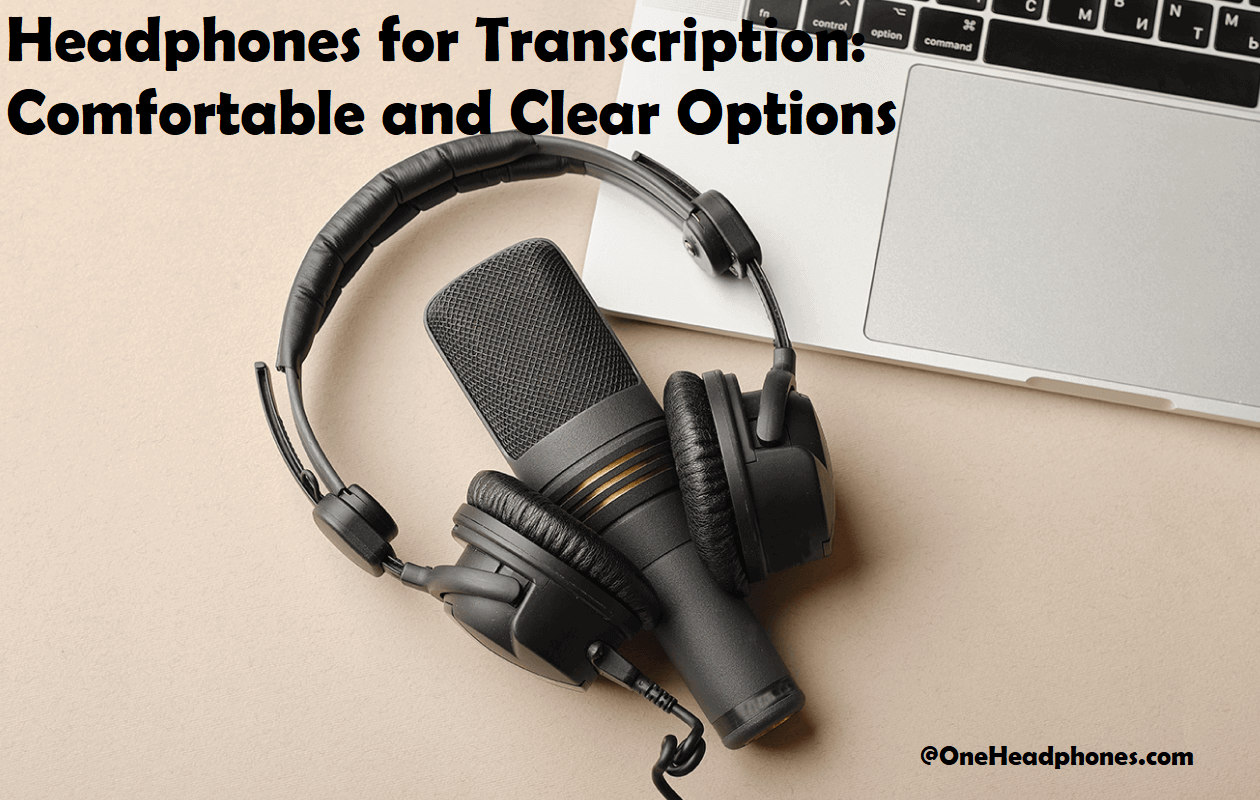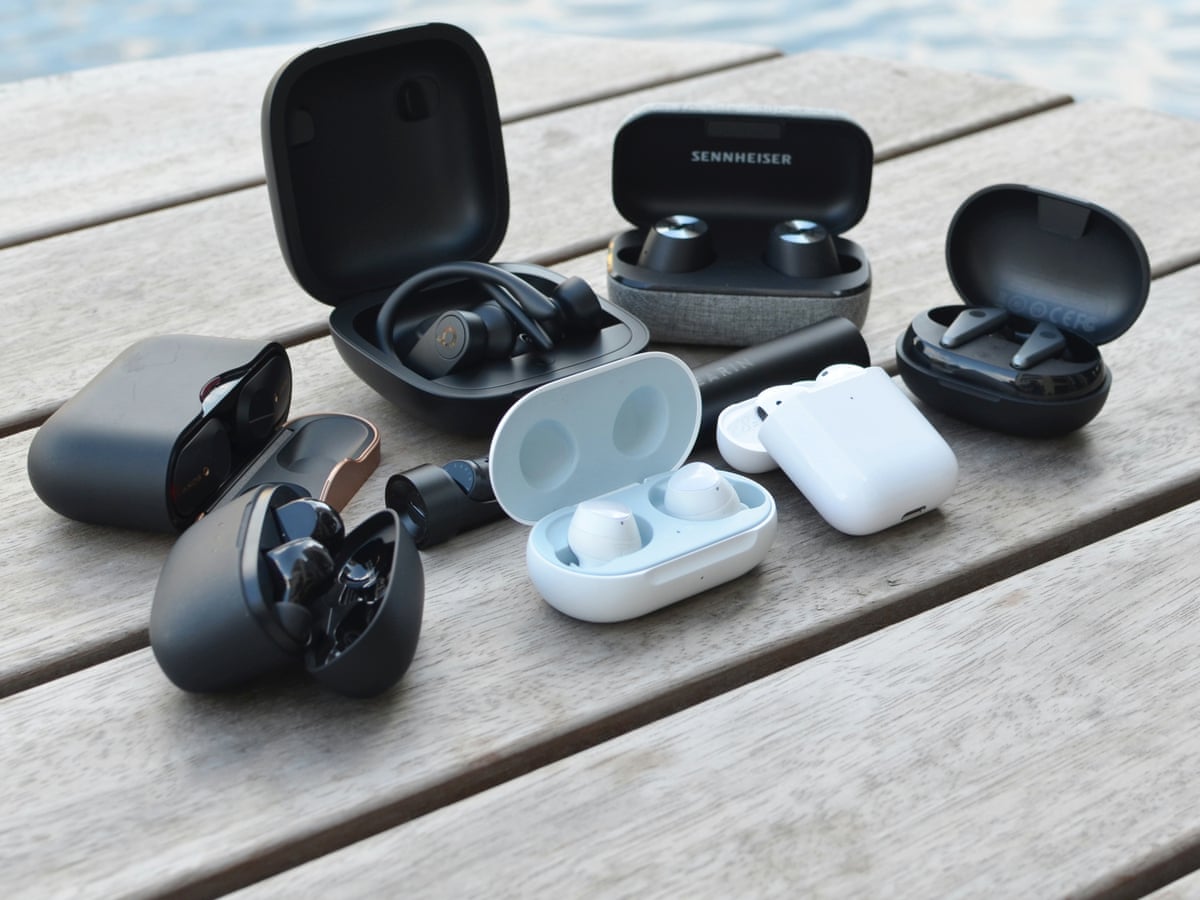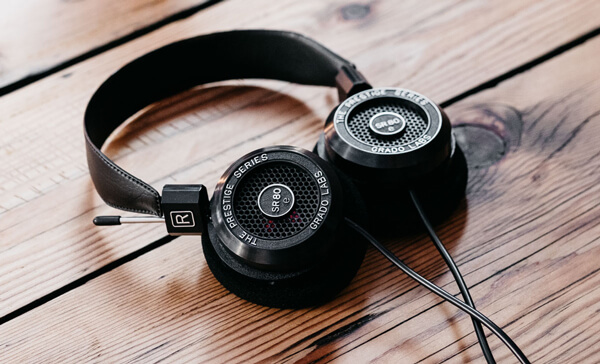Are you looking for quality, comfortable headphones for transcription? Look no further!
This guide will provide you with detailed information about the most comfortable and clear headphones available on the market. You’ll be able to find the perfect pair of headphones to transcribe your audio with ease.
Headphones are a crucial tool for transcribing audio, as they help to ensure clarity and accuracy of the transcription task. A good pair of headphones can be used for more than just playing music—they provide enhanced sound quality for transcription tasks, improving the clarity of your recorded audio and helping reduce interference from outside sounds. But with so many options available, it can be hard to know which headphones are best suited for transcription work.
This guide will provide an overview of some essential features to consider when selecting headphones for transcription work, what to look out for in terms of comfort factors, and the various types of headphones available on the market. Whether you’re using your headphones for spoken word applications like dictation or live recordings, we hope this guide will help you find a pair that delivers clear sound quality every time.
Explanation of transcription
Transcription is the process of converting an audio or video file into a written document. It’s a time-intensive job that requires attention to detail and knowledge of correct spelling, punctuation and grammar. Transcribers are often tasked with listening to audio or watching video recordings multiple times to ensure accuracy.
To make transcription easier, good headphones are necessary for transcribers. Unless you’re in a quiet space, background noise can interfere with your ability to understand what’s being said in recordings. The best headphones for transcription provide clear, balanced sound and long-term comfort — no matter how long you have to be transcribing for. In this guide we will provide information on the features you should look for in headphones as well as our top headphone recommendations for transcribers.
Importance of clear and comfortable headphones
Headphones play a key role in transcription, so it is essential to find a pair that ensures clarity and comfort. Quality headphones will help you avoid repetitive strain injuries, as well as strains due to uncomfortable listening. However, it is not always easy to find a pair with perfect sound quality and comfort at an affordable price.
Finding the right headphones for transcription requires careful consideration of several factors including earcup cushioning, build quality and bass response. The materials used to make the headband and earcups will determine the amount of cushioning they provide whilst larger earcup sizes offer better noise isolation. Bass response is essential for accurate transcription and should be considered when selecting suitable headphones.
It is important to choose headphones that fit properly otherwise you may experience discomfort or fatigue during extended transcription sessions. Over-ear headphones are a great option when it comes to comfort, however some people prefer on-ear models for freedom of movement or increased portability. A good balance between sound quality and comfort can be achieved if you take the time to read reviews before making a purchase decision.
Purpose of the guide
This guide has been designed to assist transcriptionists who are looking for a pair of comfortable, clear headphones. It focuses on the key features and advantages of different pairs of headphones suitable for transcriptionists including sound quality, comfort levels and noise cancelling qualities. Additionally, this guide includes reviews and product comparisons of some popular headphones in order to help transcriptionists make a more informed buying decision.
Transcriptionists need clear, comfortable headphones in order to hear every word spoken during recordings clearly, synthesize language quickly, and accurately transcribe long recordings without experiencing difficulty or fatigue. Therefore, it is important to take into account all factors when choosing the right pair of headphones, from sound quality and noise cancellation qualities to build materials and comfort level. In this guide we will discuss these considerations in detail so that you can find the perfect pair of headphones for your needs.
Factors to Consider When Choosing Headphones for Transcription
Beyond comfort, there are additional factors to carefully consider when shopping for headphones for transcription. These include sound quality, noise isolation and compatibility with your audio-recording device.
Sound Quality: Sound quality is an important consideration for headphones used in transcription. Choose a pair of headphones that offer clear sound without distortion and too much bass or treble for the most accurate transcripts. Look for closed-back headphones with a frequency range between 15 and 25 kHz so you can accurately hear speech recording nuances like whispers and higher-frequency pronunciation.
Noise Isolation: Using headphones with passive noise isolation can help you reduce distractions while transcribing, ensuring you don’t miss any details of the recordings. Noise-canceling or “active” headphones work best if you’re transcribing in a loud environment — whether that’s a busy office or at home with kids playing around. However, these can be expensive compared to traditional passive noise isolation models, which are just as effective at blocking out background noises while allowing you to focus on the recording task at hand.
Compatibility: Not all headphones will be compatible with your audio recording device so check specifications carefully before purchasing new models to ensure sufficient compatibility on both ends of the headset— from the media recorder to the headset itself—so that you don’t end up having problems playing back your recordings later on.
Comfort
When it comes to headphones designed specifically for transcription, comfort should be of primary consideration. Long listening sessions can quickly become uncomfortable with any headphones, but transcription tasks often require an extended amount of time wearing them. This means that finding the perfect pair of headphones that are comfortable and properly fit your head size is crucial.
When it comes to choosing comfortable headphones, you’ll want to look for circumaural or supra-aural designs such as those with padded cups or adjustable headbands. Circumaural-style headphones typically provide better sound isolation, while supra-aurals are lightweight and low profile. You’ll also want to make sure they are adjustable so you can ensure that a secure fit in order to minimize any sound leakage passing through the headphone material during playback. Furthermore, look for models with quality sealing foam or leatherette ear cushions as well as breathable materials to combat heat buildup from long listening sessions.
Headband
Headbands are the most traditional type of headphones available, and they are still a great choice for transcription tasks. Headbands fit comfortably over your ears and use soft padding or cushions to keep them in place, making them suitable long-term listening experiences.
The basic construction of a headband is that of two earphones connected by an adjustable metal or plastic piece. This construction allows you to adjust the size so that it fits perfectly over your head without being too tight, allowing you to use them comfortably for extended periods.
The sound quality of headbands varies, as does the degree of noise cancellation available but as a general rule they provide clear, straightforward audio quality and often have excellent bass response for transcription tasks. As an added bonus many come with removable cords which can be replaced if needed and feature volume controls on one headphone so you can adjust it without having to reach for your device.
Earpads
Earpads are a critical part of any pair of headphones. Quality cushioned earpads provide a comfortable fit, while having an effect on isolation, clarity and bass response. Though they may not seem like a major factor in headphones’ sound quality, their impact can be significant. Here’s what you need to know when selecting headphones for transcription or general listening use.
Leather and velour are the two common materials used for headphone earpads, each offering distinct benefits. Leather is durable and provides superior sound isolation, although it can sometimes become uncomfortable after extended use due to heat buildup inside the pad that results in sweating. Velour is more comfortable overall as it permits easier breathing than leather and will not build up heat as much, but offers slightly less sound isolation. Additionally, some manufacturers offer padding with memory foam which can mold around the listener’s ear to provide even more comfort while still offering good noise isolation (blocking out outside noises).
In terms of audio performance, thicker earpads do tend to provide better low frequencies (bass response) over thin ones because they have more air trapped inside them allowing more accurate reproduction of bass frequencies at higher volumes with less distortion; On the other hand thin pads provide better treble (high frequency) detail with lowered sound pressure levels making them ideal for quieter listening environments like recording studios.
Earpads should be washed regularly with soap and water or replaced should bacteria or dirt buildup occur; This helps avoid bacterial growth near the ears which can cause itching and further discomfort when using your headphones for an extended period of time. Finally make sure that your chosen set has replaceable pads should you want different types down the line- many headphones only come with one type of pad so it’s important to double check this beforehand!
Sound Quality
Sound quality will vary drastically between different models of headphones, so it’s important to find a pair that will provide the best audio clarity and accuracy while using them for transcription work. The goal when looking at sound quality is to find a pair that has accurate reproduction of audio in both the highs and lows.
Headphone specifications often list their frequency response; this is typically given as a range of hertz (Hz) representing the highs and lows which the headphones can reproduce accurately. If your intention is professional transcription work, aim for headphones with relatively flat frequency responses (often between 20 Hz–20 kHz), so you know every note and nuance of whatever you’re listening to will remain intact as you transfer it from audio to text.
In addition to flat frequency response, look for headphones with high sensitivity ratings (measured in decibels, dB). A high rating means the headset is capable of reaching loud volumes without distortion or “clipping” occurring — important when transcribing quiet audio sources where maximum volume may be required. Additionally, high impedance ratings are recommended if using dedicated recording equipment as they will ensure that any background noise generated by other electronic devices nearby won’t interfere with its performance.
Clarity
When it comes to transcription headphones, clarity is key. In order to accurately capture a dictation or recorded conversation, you need to be able to easily discern soft voices or specific words and phrases. Comfort plays an equally important role when selecting headphones for transcription. The quality of the headphones you choose will not only affect your accuracy but your comfort level as well. Here are the top three things you should look for in terms of clarity when selecting the best headphones for transcription.
1) Frequency response: This is an indication of how well and accurately the headphones capture various frequencies within a given soundscape. You’ll want something that can accurately reproduce subtle details as well as deep rhythms or bass tones without distorting at higher volumes. Look for models with a wide frequency range (20-20 kHz is ideal) and low distortion at higher volumes (below 0.5%).
2) Noise Cancellation: In order to effectively transcribe lengthy conversations without annoying background noise, look for features like active noise cancellation (ANC). ANC blocks out sound from outside sources so that you can conveniently focus on each word of your transcription project without distractions. Some models also offer Adaptive Noise Cancellation (ANC), which adjusts the strength of noise cancellation based on your environment and type of work being done so that it’s tailored specifically to your needs.
3) Drivers: The larger the drivers in a headphone pair, the bigger range of frequencies they’re able to produce—from low bass tones all the way up through crisp upper midrange sounds. Look for driver sizes that are 40mm or larger—you should expect richer sound quality with larger drivers.
Noise-cancellation
Noise-cancellation refers to headphones that actively listen to environmental sound and create the opposite sound wave of what it is detecting, canceling out much of the noise. This feature works better for low frequency noises, like those generated by a plane’s engine or an A/C unit, but has minimal effect on higher frequency sounds, like speech. Headsets with this technology are great for transcriptionists who may have a noisy work environment.
The market is full of noise-cancelling headphones promising complete silence and total isolation from outside sound. While this can’t be delivered perfectly in practice, active noise-cancelling headphones can provide decent reduction of intrusive background noises such as air conditioners hum, things going on in the background at the office or chatter in public places where you might be recording your audio files. Models that specifically include Speech Guard technology can pick up audio details more clearly than standard noise-cancelling devices due to their ability to retain all incoming sound information which is then subjected to highly precise positional filtering .
Durability
Due to their frequent use, it is essential to buy long-lasting headphones when using them for transcription. Waterproof or dustproof models can ensure that they can be used in the most demanding environments, making them ideal for transcription tasks.
Also, look out for adjustable headbands, so they fit all sizes of heads as well as cushioned earpieces which offer increased comfort during prolonged use. Even if you’re not looking for child-friendly headphones, ensure that they are sturdy and tough and have streamlined designs; these attributes invariably lead to greater durability and robustness of your headset.
Conclusion
In conclusion, we hope you have the confidence to make a well-informed decision when purchasing a pair of headphones for transcription. There is no single, best type of headphones – it all depends on personal preference and needs. Consider what features are essential to you, such as comfort and sound quality, then compare pairs within your price range to make the right choice.
We would encourage you to buy from reputable manufacturers and sellers to get maximum value for your money. Many headphone models are designed for general use and may not be suited for transcription purposes, so do your research before making a purchase. Finally, if you’re using headphones connected to a digital recorder or computer system, be sure to set up the recording environment properly so that background noise is minimized and you can achieve the highest-quality recordings possible.
FAQ’s
Which earphones are best for transcription?
Earphones with good sound quality and comfortable fit are ideal for transcription. Some popular options are Bose QuietComfort Earbuds, Sony WF-1000XM4, and Apple AirPods Pro.
What is the best headset for medical transcription?
Headsets with noise-canceling technology and clear sound are ideal for medical transcription. Some popular options are Philips SpeechOne, Jabra Evolve 75, and Plantronics Blackwire 8225.
Are noise-canceling headphones good for transcription?
Yes, noise-canceling headphones are great for transcription as they can eliminate background noise and help you focus on the audio.
What type of headphones are the most comfortable?
Over-ear headphones with soft padding are generally the most comfortable for extended use. However, this can vary based on personal preference and head size.
How do I get better at transcribing by ear?
Practice is key to improving your transcribing skills. You can also try slowing down the audio, using transcription software, and improving your listening skills.
What is the best audio format for transcription?
WAV and MP3 are the most common audio formats used for transcription as they are easy to work with and provide good sound quality.
How do you transcribe hard to hear audio?
You can try adjusting the audio settings, using headphones or speakers with better sound quality, and using transcription software that can enhance the audio.
What are transcription headphones?
Transcription headphones are headphones that are designed for transcribing audio. They usually have features such as noise cancellation, clear sound, and comfortable fit.
What do I need for audio transcription?
You need a computer, headphones or earphones, transcription software, and a good internet connection to transcribe audio.
What is the most accurate transcription?
The accuracy of transcription depends on various factors such as the quality of audio, the complexity of the content, and the skill of the transcriber. However, some popular transcription software such as Otter.ai, Rev, and Trint are known for their high accuracy.
See Also-
- Best skullcandy headphones
- Best studio headphones under 200
- Best study headphones
- Best surround sound headphones for movies
- Best non gaming headphones for gaming

